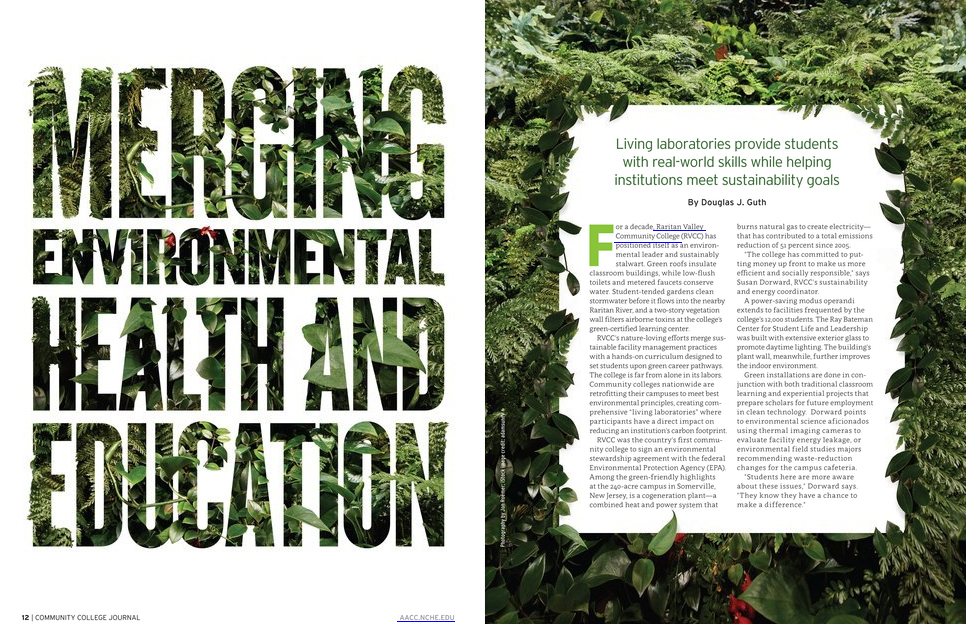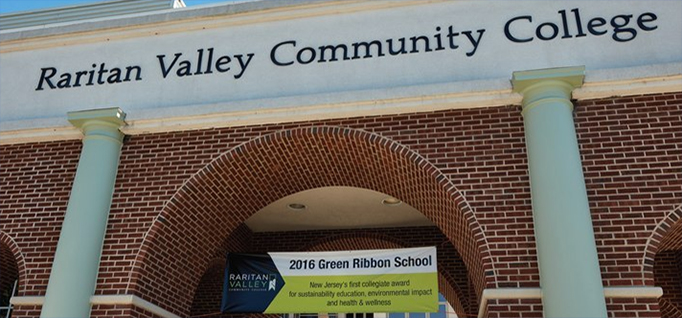Merging environmental health and education
By Douglas J. Guth
August 17, 2016
Living laboratories provide students with real-world skills while helping institutions meet sustainability goals.
For a decade, Raritan Valley Community College (RVCC) has positioned itself as an environmental leader and sustainably stalwart. Green roofs insulate classroom buildings, while low-flush toilets and metered faucets conserve water. Student-tended gardens clean stormwater before it flows into the nearby Raritan River, and a two-story vegetation wall filters airborne toxins at the college’s green-certified learning center.
RVCC’s nature-loving efforts merge sustainable facility management practices with a hands-on curriculum designed to set students upon green career pathways. The college is far from alone in its labors. Community colleges nationwide are retrofitting their campuses to meet best environmental principles, creating comprehensive “living laboratories” where participants have a direct impact on reducing an institution’s carbon footprint.
RVCC was the country’s first community college to sign an environmental stewardship agreement with the federal Environmental Protection Agency (EPA). Among the green-friendly highlights at the 240-acre campus in Somerville, New Jersey, is a cogeneration plant—a combined heat and power system that burns natural gas to create electricity—that has contributed to a total emissions reduction of 51 percent since 2005.
“The college has committed to putting money up front to make us more efficient and socially responsible,” says Susan Dorward, RVCC’s sustainability and energy coordinator.
Green installations are done in conjunction with both traditional classroom learning and experiential projects that prepare scholars for future employment in clean technology. Dorward points to environmental science aficionados using thermal imaging cameras to evaluate facility energy leakage, or environmental field studies majors recommending waste-reduction changes for the campus cafeteria.
“Students here are more aware about these issues,” Dorward says. “They know they have a chance to make a difference.”

Connecting sustainability and curriculum
Aging infrastructure, increasing enrollment and decreasing budgets are pressuring colleges to create alternative education delivery vehicles that keep their young charges engaged. Josh Gamer, dean of the integrated technology division at Western Technical College (WTC) in La Crosse, Wisconsin, says the college’s robust energy-saving initiatives are part of a larger sustainability-related philosophy that permeates the entire campus.
“Our living lab isn’t a showcase, or an exhibition you look at,” Gamer says. “It’s meant to add to the knowledge of the people that experience it.”
WTC has reached $1 million in energy savings due to long-term sustainable practices, Gamer notes. This focus includes hydro power and solar facilities that produce 1 gigawatt of power annually, the equivalent of taking 88 homes off the grid. An Energy Conservation Management Program (ECMO) calls for a reduction in electricity usage by shutting off lights and powering down equipment when not in operation.
At WTC and other colleges with living labs, effective environmental and sustainability education is built from the infrastructure on down. For example, WTC’s 50-kilowatt solar array is available for students eager to study its electricity output, giving them an advantage on how such technology is designed, built and maintained. The college also is planning to mount solar panels at one of its regional locations to serve as a power source and unique classroom.
“It’s about identifying a space and figuring out what kind of curriculum we can connect to it,” says Gamer. “How can we promote the space so people get interested?”
The college’s newly opened Integrated Technology Center brings the entire living lab concept together in a single 125,000-square-foot space. The facility is one of only 16 LEED (Leadership in Energy and Environmental Design)-certified buildings in state, harnessing solar walls, LED lighting and other resources. Runoff water from the center is collected in an underground system to be used for irrigation and flushing toilets. The facility’s sustainable ideals are married to a collaborative classroom structure that brings together 29 career opportunities in manufacturing, agriculture, architecture, STEM (science, technology, engineering and math) and more.
Learn more: read the full article in the August/September digital Community College Journal. All staff and faculty at AACC member institutions have access.
Continue the conversation on our LinkedIn group.



